

Tifernum Tiberinum
Tifernum Tiberinum had presumably been federated to Rome from the late 3rd century BC and had probably became a municipality in 90 BC. Surviving inscriptions indicate that it was assigned to the Clustumina tribe.
The earliest surviving historical records of Tifernum Tiberinum date to the 1st century AD, when Pliny the Elder (‘Natural History’, 3:19) placed “the Tifernates surnamed Tiberini” among the people of the Augustan Sixth Region (Umbria).
Municipium
According to Cristina Migliorati (referenced below, at p. 379 and Figure 1) the Roman city was probably located on a slightly raised alluvial terrace that coincided with the southern part of modern Città di Castello. The northern perimeter was probably marked by the Scatorbia, a tributary of the Tiber that is now canalised underground, the line of which is marked by Via della Scatorbia, Via dei Fucci and Via dei Lanari. Simone Sisani (referenced below, at p. 71) suggested that the north-south roads now named Via Angeloni and Corso Vittorio Emanuele follow an urban tract of the Roman Via Tibertina that served as the cardo maximus of the city. However, this road might alternatively have skirted its eastern boundary, which would lend weight to a local tradition that the present Piazza Gabriotti stands on the site of the Roman forum.
Excavations of the site of the ex-Fattoria Autonoma Tabacchi (the area bounded by Via Guglielmo Oberdan, Borgo Farinario and Via delle Santucce) have unearthed what are probably the remains of a small amphitheatre (1st century AD). The remains of what seem to have been the public baths have been unearthed at the south west corner of the site (at the junction of Borgo Farinario and Via delle Santucce). Two inscriptions found here, both of which date to the period 1-30 AD and are now in the deposit of the Museo Archeologico, Perugia, commemorate men who belonged to the Clustumina tribe:
-
✴An inscription (AE 1997 0492) recorded Gaius Palius, son of Gaius, a member of the equestrian order to whom the urban plebs dedicated honours, possibly after his death.
-
✴Another inscription (AE 1997, 0493) recorded Gaius Tussidius Marcianus, an aedile.
These men presumably contributed to the cost of building the amphitheatre or to that associated with the spectacles that were held here. (The inscriptions are illustrated in the work edited by Marisa Scarpignato referenced below).
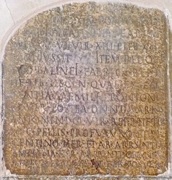
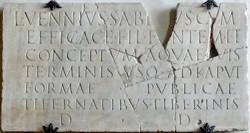
CIL XI 5939 CIL XI 5942
Two inscriptions now in Palazzo Comunale are translated in the website of Bill Thayer:
-
✴An inscription (CIL XI 5939, 2nd century AD) that was found in Piazza Matteotti commemorates an unknown man who had left a considerable amount of money and a building for housing the baths to “the commonwealth of Tifernum Tiberinum”.
-
✴An inscription (CIL XI 5942, 1st century AD) that was found at Fontecchio commemorates Lucius Vennius Sabinus and his son Efficax, who donated a water supply system of some kind to the people of Tifernum Tiberinum.
Fragments of Roman mosaics have been found:
-
✴ in private houses at:
-
•4 Via del Borghesi (1st century BC, the oldest surviving Roman remains in the city);
-
•26 Via delle Santucce (2nd century AD); and
-
•2 Via del Gemignano (2nd century AD); and
-
✴in excavations carried out in the 1950s in the area of the the ex-Fattoria Autonoma Tabacchi “near the church of Santa Caterina”. This stretch of black and white mosaic (2nd century AD) was apparently recomposed in a nearby house.
Many of these mosaic fragments are illustrated in the work edited by Marisa Scarpignato referenced below.
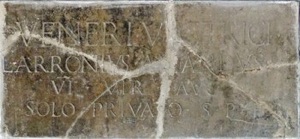
CIL XI 5928
An inscription (CIL XI 5928, 2nd century AD) that was found in Via Marconi, which survives in Palazzo Comunale, records a temple dedicated to Venus Victrix (Venus the Conqueror). It had been built by Lucius Arronius Amandus, a sevir augustalis (member of a magistracy of six men). Excavations in 1910 of a site between Porta San Florido and the Tiber uncovered a large public building with at least four rooms paved in black and white mosaics (now lost). Cristina Migliorati (referenced below) suggested that this building and the temple mentioned in the inscription above were associated with a river port analogous to that at Pagliano, near Orvieto.
Veteran Settlement
An entry in the Gromatici Veteres (a record of land appropriated for colonisation by veteran soldiers) records the reallocation of centuriated land in the “Ager Tifernus” the time of the Emperor Tiberius (14-37 AD):
-
“The land of Tifernum was allocated in centuriae. Afterwards, by order of the Emperor Tiberius, when the soldiers who had occupied the land had died out, it was allocated to others, fewer in number” (translated by Brian Campbell, referenced below, at p. 175).
Brian Campbell (at p. 410, note 48) speculated that:
-
“It is possible that the compiler of the Liber had been misled by a false etymology of ‘Tiberinum’ into his belief that Tiberius made allocations here.”
The original allocation might have been associated with the the formation of the colony that was established at Hispellum in 41 BC: a now-lost inscription (CIL XI 5936) from an unknown location at Città di Castello, which probably dated to the Augustan period (27 BC - 14 AD), read:
C. Fadio C. f./ Lem(onia)/ cent(urioni) leg(ionis) XI
ex test(amento)/ Arbit(ratu) Fadiae C. f./ Paullinae
It commemorated Caius Fadius, a centurion of Legio XI who belonged to the Lemonia, the tribe of Hispellum. Thus, Paolo Braconi (referenced below, at p. 45) suggested that:
-
“We may wonder whether the colony of Spello had not penetrated ... the fertile plains of the ager Tiferinus. In any event, this territory was separated from that of Hispellum only by the small municipality of Arna. In fact, the territory of Perusia, which was theoretically situated between Arna and Tifernum Tiberinum, was reduced in the aftermath of the Perusine War to a single mile around the city. It follows that the lands placed at the disposal of the triumvirs [at this point] constituted an immense continuum which connected the upper Tiber valley with the Valle Umbra ...” (my translation).
Enrico Zuddas and Maria Carla Spadoni (referenced below, p. 60) were of the same opinion:
-
“Perhaps [Fadius] was a veteran of Spello who received land [at Tifernum Tiberinum, modern Città di Castello]: indeed the area of Città di Castello has a centuriation that is coeval with that of Hispellum” (my translation).
Enrico Zuddas and Maria Carla Spadoni (referenced below, p. 60) pointed out that graffiti on slingshots that survive from the Perusine War indicate that Fadius’ legion fought in this conflict. However, this colonial enclave was not necessarily formed immediately after the Perusine War: Laurence Keppie (referenced below, at p. 77 and p. 79) recorded that veterans of Legio XI were settled at Ateste in northeastern Italy after the Battle of Actium, and other veterans of the legion could have been assigned to Hispellum at this point.
Paolo Braconi (referenced below, at p. 38) pointed out that there was another link between Tifernum Tiberinum and Hispellum: the gens Grania was represented at both places:
-
✴Marcus Granius Marcellus, the proconsul of Bithynia in 14-15 AD, owned a villa at what is now San Giustino, outside Tifernum Tiberinum (later the villa of Pliny the Younger, discussed below).
-
✴Marcus Granius, who was one of the duoviri who commissioned a statue of Venus a temple in the sanctuary at Villa Fidelia below Hispellum (evidenced by CIL XI 5264) soon after colonisation.
He pointed out that:
-
“Marcus Granius Marcellus ... cannot be considered as exactly a member of the local élite, but we shall proceed from the hypothesis that his property in the ager Tiferinus may have belonged to his ancestor Marcus Granius [recorded at Hispellum], who was probably his father ...” (my translation).
He also argued (at pp. 46-7) that the Marcii Granii and the Fadii (the family of Caius Fadius, discussed above). Enrico Zuddas and Maria Carla Spadoni (referenced below, p. 61) similarly observed that:
-
“[The Marcii Granii] were not a local family, but came from Campania (Puteoli or Allifae), and had perhaps arrived [in Umbria] only at the time of the deduction of the colony [at Hispellum]. Fadius and his family could have followed the same path, since they were also from Campania (from Allifae)” (my translation).
Pliny Family Estate
As described on the page on the estate on Colle Plinio, series of inscribed ceramics from the site, which are now in the Museo Pliniano, throw light on the ownership of the estate here over time:
-
✴A number of objects stamped GRANI and with consular dating suggest that Marcus Granius Marcellus, who was proconsul in Bithynia in 14-15 AD, owned the estate from ca. 2BC.
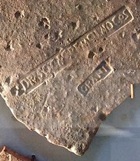
-
✴Marcus Granius Marcellus was charged with having insulted the Emperor Tiberius in 15 AD, and his property was confiscated. Tiles stamped “CAESAR” probably belong to this period.
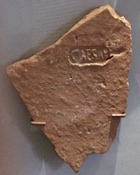
-
✴Tiles stamped C.P.S. (Caius Plinius Secundus) indicate that estate passed to Pliny the Elder, a nephew of Marcus Granius Marcellus, probably under the Emperor Vespasian (69-79 AD).
-
✴Other tiles stamped C.P.C.S. (Caius Plinius Caecilius Secundus) suggest that it passed to Pliny the Younger, presumably on the death of Pliny the Elder in 79 AD.
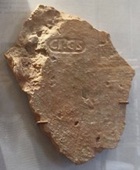
Pliny the Younger
In his Letter XXXVIII to Fabatus (his wife’s grandfather), Pliny the Younger wrote that:
-
“There is a town near my estate, called Tifernum Tiberinum, which, with more affection than wisdom, put itself under my patronage when I was yet a youth. These people celebrate my arrival among them, express the greatest concern when I leave them, and have public rejoicing whenever they hear of my preferments. By way of requiting their kindnesses ... I have built a temple in this place, at my own expense and , since it is finished, it would be a sort of impiety to put off its dedication any longer.”
In an earlier letter to the Emperor Trajan, when the temple was still in the planning stage, Pliny the Younger provided more information (albeit that Tifernum Tiberinum was not explicitly named):
-
“After your late sacred father [the Emperor Nerva] had ... exhorted and encouraged the public to acts of munificence, I implored his permission to remove the several statues that I had of the former emperors to my corporation [i.e. to the municipal authorities of Tifernum Tiberinum], and .... to add his own to their number. ... He was pleased to grant my request, and ... I immediately ... wrote to the decurii [magistrates] to request that they would allot a piece of ground upon which I might build a temple at my own expense; and they ... offered me the choice of any site I might think proper. However, [various distraction, including the death of Nerva] prevented my proceeding with that design. But I have now ... a convenient opportunity of making an excursion ... My first request, then, is that you would permit me to adorn the temple I am going to erect with your statue, and next .... that you would indulge me with leave of absence ... for 30 days. I cannot give myself a shorter time, as the town and the estate of which I am speaking lie more than 150 miles from Rome”.
No trace of this temple, which seems to have been devoted to the imperial cult, survives.






